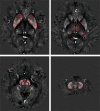Quantitative Assessment of Deep Gray Matter Susceptibility and Correlation With Cognition in Patients With Liver Cirrhosis
- PMID: 39778978
- PMCID: PMC11710887
- DOI: 10.1002/brb3.70240
Quantitative Assessment of Deep Gray Matter Susceptibility and Correlation With Cognition in Patients With Liver Cirrhosis
Abstract
Background and objectives: Accumulation of metals quantified by quantitative susceptibility mapping (QSM) in deep gray matter (DGM) and their impact on cognition have not been studied in patients with liver cirrhosis. This study aims to use QSM to investigate the association between DGM susceptibility and cognition in cirrhotic patients.
Methods: Thirty cirrhotic patients and 30 age-, gender-, and education-matched controls were imaged using a multiecho gradient-echo sequence for QSM analysis in a 3T scanner. The susceptibility values were determined for the caudate nucleus (CN), putamen (PU), globus pallidus (GP), thalamus (TH), red nucleus (RN), substantia nigra (SN), and dentate nucleus (DN). All subjects underwent number connection test A (NCT-A), digit substitution test (DST), and Montreal Cognitive Assessment (MoCA). Comparisons between the two groups and the correlation between the susceptibility values and neuropsychological scores were analyzed.
Results: The susceptibility values of bilateral CN, TH, and RN were significantly lower in cirrhotic patients. Cirrhotic patients exhibited significantly prolonged NCT-A time and decreased DST and MoCA scores. The NCT-A, DST, MoCA, and sub-domain scores were correlated with susceptibility values of RN, DN, SN, and CN, respectively. The susceptibility value of the left RN was a predictor variable for the DST, MoCA, and visuospatial-executive scores; those of the right CN and left RN were predictor variables for the naming score, and that of the left SN was an independent predictor variable for the language score.
Conclusions: Altered susceptibility values of DGM measured by QSM are potential quantitative indicators of cognitive impairment in cirrhotic patients.
Keywords: cognitive impairment; deep gray matter; liver cirrhosis; metal accumulation; quantitative susceptibility mapping.
© 2025 The Author(s). Brain and Behavior published by Wiley Periodicals LLC.
Conflict of interest statement
The authors declare no conflicts of interest.
Figures




Similar articles
-
Quantitative Susceptibility Mapping of Brain Iron Relating to Cognitive Impairment in Hypertension.J Magn Reson Imaging. 2022 Aug;56(2):508-515. doi: 10.1002/jmri.28043. Epub 2022 Jan 5. J Magn Reson Imaging. 2022. PMID: 34989062
-
Age-dependent changes in brain iron deposition and volume in deep gray matter nuclei using quantitative susceptibility mapping.Neuroimage. 2023 Apr 1;269:119923. doi: 10.1016/j.neuroimage.2023.119923. Epub 2023 Feb 3. Neuroimage. 2023. PMID: 36739101
-
Increased Iron Deposition on Brain Quantitative Susceptibility Mapping Correlates with Decreased Cognitive Function in Alzheimer's Disease.ACS Chem Neurosci. 2018 Jul 18;9(7):1849-1857. doi: 10.1021/acschemneuro.8b00194. Epub 2018 May 15. ACS Chem Neurosci. 2018. PMID: 29722955
-
Quantitative Susceptibility Mapping Values Quantification in Deep Gray Matter Structures for Relapsing-Remitting Multiple Sclerosis: A Systematic Review and Meta-Analysis.Brain Behav. 2024 Oct;14(10):e70093. doi: 10.1002/brb3.70093. Brain Behav. 2024. PMID: 39415615 Free PMC article.
-
Quantitative susceptibility mapping for iron monitoring of multiple subcortical nuclei in type 2 diabetes mellitus: a systematic review and meta-analysis.Front Endocrinol (Lausanne). 2024 Mar 6;15:1331831. doi: 10.3389/fendo.2024.1331831. eCollection 2024. Front Endocrinol (Lausanne). 2024. PMID: 38510699 Free PMC article.
References
-
- Abdullaev, Y. G. , and Melnichuk K. V. 1997. “Cognitive Operations in the Human Caudate Nucleus.” Neuroscience Letters 234, no. 2‐3: 151–155. - PubMed
MeSH terms
Grants and funding
LinkOut - more resources
Full Text Sources
Medical

